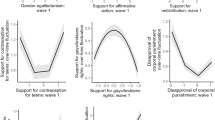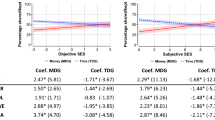Abstract
How do ‘people power’ movements succeed when modest proportions of the population participate? Here we propose that the effects of social movements increase as they gain momentum. We approximate a simple law drawn from physics: momentum equals mass times velocity (p = mv). We propose that the momentum of dissent is a product of participation (mass) and the number of protest events in a week (velocity). We test this simple physical proposition against panel data on the potential effects of movement momentum on irregular leader exit in African countries between 1990 and 2014, using a variety of estimation techniques. Our findings show that social movements potentially compensate for relatively modest popular support by concentrating their activities in time, thus increasing their disruptive capacity. Notably, these findings also provide a straightforward way for dissidents to easily quantify their coercive potential by assessing their participation rates and increased concentration of their activities over time.
This is a preview of subscription content, access via your institution
Access options
Access Nature and 54 other Nature Portfolio journals
Get Nature+, our best-value online-access subscription
$29.99 / 30 days
cancel any time
Subscribe to this journal
Receive 12 digital issues and online access to articles
$119.00 per year
only $9.92 per issue
Buy this article
- Purchase on Springer Link
- Instant access to full article PDF
Prices may be subject to local taxes which are calculated during checkout


Similar content being viewed by others
Data availability
The STATA dataset that supports the findings of this study is publicly available from the Harvard Dataverse at https://doi.org/10.7910/DVN/JYM19E.
Code availability
The custom code that supports the findings of this study is publicly available from the Harvard Dataverse at https://doi.org/10.7910/DVN/JYM19E.
References
Centola, D., Becker, J., Brackbill, D. & Baronchelli, A. Experimental evidence for tipping points in social convention. Science 360, 1116–1119 (2018).
M. Lichbach, The Rebel’s Dilemma (Univ. Michigan Press, 1994).
Chenoweth, E. The surprising success of nonviolent resistance. TEDxBoulder https://www.youtube.com/watch?v=YJSehRlU34w (21 September 2013).
Kanter, R. M. Some effects of proportions on group life: skewed sex ratios and responses to token women. Am. J. Sociol. 82, 965–990 (1977).
Dahlerup, D. From a small to a large minority: women in Scandinavian politics. Scand. Polit. Stud. 11, 275–298 (1988).
Marwell, G. & Oliver, P. The Critical Mass in Collective Action (Cambridge Univ. Press, 1993).
Chenoweth, E. & Stephan, M. Why Civil Resistance Works: The Strategic Logic of Nonviolent Conflict (Columbia Univ. Press, 2011).
Branch, A. & Mampilly, Z. Africa Uprising: Popular Protest and Political Change (Zed, 2015).
Badri, B. & Tripp, A. Women’s Activism in Africa (Zed, 2017).
Sharp, G. The Politics of Nonviolent Action (Porter Sargent, 1973).
Sutton, J., Butcher, C. & Svensson, I. Explaining political jiu-jitsu: institution-building and the outcomes of regime violence against unarmed protests. J. Peace Res. 51, 559–573 (2014).
Salehyan, I. et al. Social conflict in Africa: a new database. Int. Interact. 38, 503–511 (2012).
Goemans, H. Gleditsch, K. & Chiozza, G. ARCHIGOS: A Data Set on Leaders 1875–2004 (2009).
Salehyan, I. & Hendrix, C. Social Conflict Analysis Database (SCAD) v.3.3 (2017).
Sullivan, C. M. Undermining resistance: mobilization, repression, and the enforcement of political order. J. Conflict Resolut. 60, 1163–1190 (2016).
Martin, B. Justice Ignited: The Dynamics of Backfire (Rowman & Littlefield, 2007).
Davenport, C. State repression and political order. Annu. Rev. Polit. Sci. 10, 1–23 (2007).
Belgioioso, M. Going underground: resort to terrorism in mass mobilization dissident campaigns. J. Peace Res. 55, 641–655 (2018).
Chenoweth, E. & Schock, K. Do contemporaneous armed challenges affect the outcomes of mass nonviolent campaigns? Mobilization 20, 427–451 (2015).
Acharya, G. The People Want: A Radical Exploration of the Arab Uprising (Univ. Calif. Press, 2013).
Dalacoura, K. The 2011 uprisings in the Arab Middle East: political change and geopolitical implications. Int. Aff. 88, 63–79 (2012).
Collier, P. & Hoeffler, A. Coup Traps: Why Does Africa Have so Many Coups d’etat? (Oxford Univ., 2015).
World Development Indicators (World Bank, 2018).
Fearon, J. & Laitin, D. Ethnicity, insurgency, and civil war. Am. Pol. Sci. Rev. 97, 75–90 (2003).
Hvistendahl, M. Young and restless can be a volatile mix. Science 333, 552–554 (2011).
LaGraffe, D. The youth bulge in Egypt: an intersection of demographics, security, and the Arab Spring. J. Strateg. Secur. 5, 65–80 (2012).
Nordås, R. & Davenport, C. Fight the youth: youth bulges and state repression. Am. J. Polit. Sci. 57, 926–940 (2013).
Rivera Celestino, M. & Skrede Gleditsch, K. Fresh carnations or all thorn, no rose? Nonviolent campaigns and transitions in autocracies. J. Peace Res. 50, 385–400 (2013).
Bamert, J., Gilardis, F. & Wasserfallen, F. Learning and the diffusion of regime contention in the Arab Spring. Res. Polit. 2, 1–9 (2015).
Pinckney, J. When Civil Resistance Succeeds: Lessons for Building Democracy after Nonviolent Popular Uprisings (International Center on Nonviolent Conflict, 2018).
Bayer, M., Bethke, F. S. & Lambach, D. The democratic dividend of nonviolent resistance. J. Peace Res. 53, 758–771 (2016).
Engler, M. & Engler, P. This Is An Uprising: How Nonviolent Revolt is Shaping the 21st Century (Nation, 2016).
Acknowledgements
We thank D. K. Cohen, J. di Salvatore, C. Dworschak, C. Hendrix, D. Johnson, Z. Marks, E. Perkoski, K. Sikkink, T. Svoronos, P. Vianello and the participants of a Research Colloquium at the Carr Center for Human Rights Policy for their input, as well as A. Tischner, M. Berger, P. Engler and the participants of the 2014 James Lawson Institute for conversations that helped to inspire this study. The authors received no specific funding for this work.
Author information
Authors and Affiliations
Contributions
E.C. derived the idea, and collected and coded data on the dependent variable. M.B. produced the compiled dataset. M.B. and E.C. formulated the hypothesis, designed the research, performed the analyses, produced the tables and graphs, discussed the results, and provided input to the manuscript.
Corresponding author
Ethics declarations
Competing interests
The authors declare no competing interests. Correspondence and requests for materials should be addressed to E.C. or M.B.
Additional information
Peer review information: Primary Handling Editor: Aisha Bradshaw.
Publisher’s note: Springer Nature remains neutral with regard to jurisdictional claims in published maps and institutional affiliations.
Supplementary information
Supplementary Information
Supplementary Figure 1, Supplementary Tables 1–17 and Supplementary Discussion.
Rights and permissions
About this article
Cite this article
Chenoweth, E., Belgioioso, M. The physics of dissent and the effects of movement momentum. Nat Hum Behav 3, 1088–1095 (2019). https://doi.org/10.1038/s41562-019-0665-8
Received:
Accepted:
Published:
Issue Date:
DOI: https://doi.org/10.1038/s41562-019-0665-8
This article is cited by
-
Politik auf der Straße? Zum Forschungsstand zu sozialen Bewegungen, Protest und Zivilgesellschaft
Zeitschrift für Vergleichende Politikwissenschaft (2022)
-
Vom Protest- zum Quarantänejahr: Neue Arenen der Konfliktaushandlung
Zeitschrift für Friedens- und Konfliktforschung (2020)



